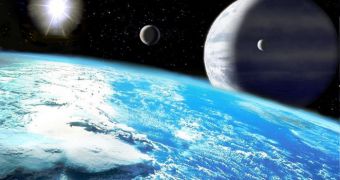According to the best data available from extrapolations, it would appear that our galaxy may be home to no less than 50 billion exoplanets. The figure is still pretty much estimative, and planet-hunting telescopes have only found around 1,200 to date, but astronomers are pretty confident in it.
The number is based on some of the most sophisticated models available to scientists today. It also takes into account various probabilities and possibilities. Experts say that technological advancements and time will be the only ones to prove the proposed number wrong.
Until today, the most advanced planet-seeking observatory, the NASA Kepler space telescope, only managed to find around 1,235 candidate planets, of which about 70 to 90 percent are expected to be confirmed as exoplanets.
One of the most interesting things about this spacecraft is that it managed to discover all these space objects in a relatively small portion of the night sky, and that it has only been online since March 2009.
“I am really delighted to find that we are seeing so many candidates. It means there's a very rich ocean of planets out there to explore,” explained Kepler's principal investigator, William Borucki.
He was a part of the team that presented an update on Kepler's discoveries. The presentation was held earlier this month, at the annual meeting of the American Association for the Advancement of Science (AAAS 2011), in Washington, DC.
“What Kepler has found, in fact, is approximately for every two stars we are seeing a planet, or candidate planet. The number of candidates per star is about 44 percent,” the expert added.
“Kepler has identified this bonanza of candidate planets. Large numbers of multiple planet systems have been detected,” said Harvard-Smithsonian Center for Astrophysics (CfA) Kepler scientist Matthew Holman.
If we consider that there are about 100 billion stars of all shapes and sizes in the Milky Way, then it stands to reason that the number of exoplanets could be as high as 50 billion, the team explained.
However, the chance of finding a second Earth is still the same as before Kepler. Of the 1,200+ exoplanetary candidates discovered, only 54 appear to be located in their stars' habitable zones.
This is the distance from the stellar surface where temperatures are just right to support the existence of liquid water. Earth is also located in the center of the Sun's habitable zone, Space reports.
In addition, the Kepler survey has also discovered some 68 planetary candidates the size of our planet, which astronomers consider one of the best possible places to start in our search for extraterrestrial life.

 14 DAY TRIAL //
14 DAY TRIAL //